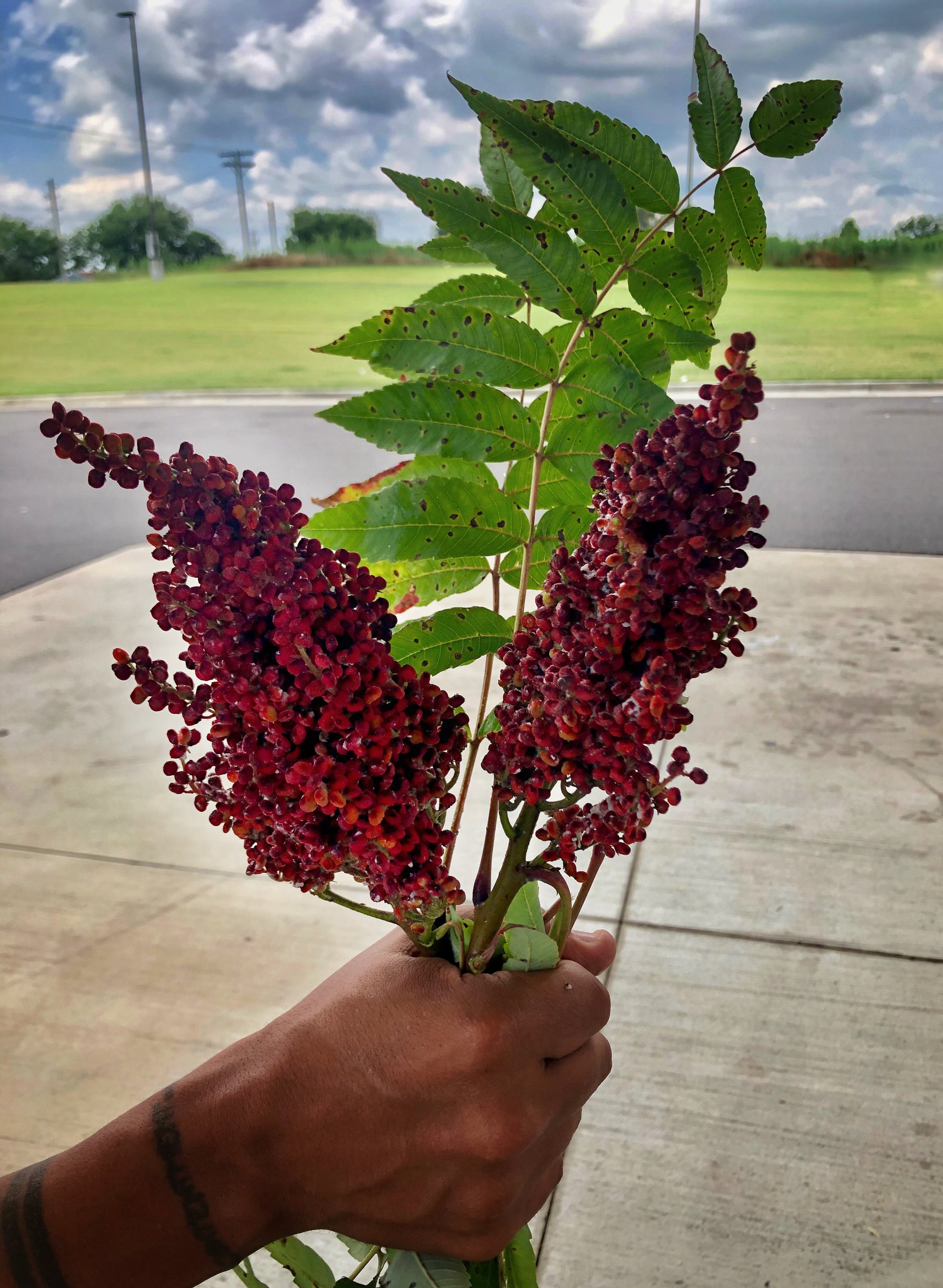Wild Sumac-ade
Sumac-ade. It doesn’t get much easier or more refreshing.
Yes, there is a difference between edible sumac and the poisonous varieties that produce the rash inducing urisol oil. The edible variety is tasty, easy to gather, full of vitamin C and purportedly many other health benefits. The poisonous variety is no bueno. Visually, the differences are fairly obvious.
We are going after is what is commonly known as the staghorn sumac. The deep red, conical shaped, clustered berries of the staghorn sumac are covered in a gentle “fuzz” that is reminiscent of a deer in velvet, thus the name. When the berries turn red in the summer, it is one of the most easily recognizable edible plants in my area. Poison sumac has small clusters of white berries and is quite apparently a different variety and easy to avoid. To be frank, I don’t know that I have ever even seen poison sumac in the wild. Admittedly, almost all of my woods experience is in Missouri and Arkansas, places without a real distribution of the plant. If you live in an area where poison sumac is more common, use the resources at your disposal to make sure you can identify the different varieties. Don’t be intimidated though, a quick google search should reveal that it would be difficult to confuse the two.
Wild, edible sumac is a sun loving plant that grows on a rhizome structure. That means that it grows in big clusters, spreading through an underground network of shallow roots. This makes it easy to collect a good amount, quickly. The berries have a pleasant, very tart, and slightly fruity flavor. I’d describe it as reminiscent of a Sweet-Tart candy, without the sweet part. Native North Americans used this plant as a food and medicine for millennia and it remains a popular spice agent in middle-eastern cooking today. On a recent family trip to Northwest Arkansas, I noticed that the interstate medians and side ditches boasted huge populations of staghorn sumac, much of which was turning the bright, deep red color you want on the berries if they are to be used for cooking. On the return trip I pulled over and grabbed a few handfuls so my family could enjoy the summer treat known as “sumac-ade.”
Sumac-ade is just what it sounds like, a lemonade type drink that derives its tartness and flavor from sumac berries as opposed to lemons. I’m hesitant to even call this a recipe, because it’s so simple and has so few ingredients. I’m more inclined to say that this is really more me explaining a process. The only ingredients involved in this process are wild sumac berries, sugar and water.
Ingredients
Staghorn sumac berries
Cold water
Sugar (to taste)
1. After gathering the sumac berries, give them a very quick rinse in cold water just to make sure you are removing any surface dirt or bugs. Don’t rinse too thoroughly or you will remove the tart, sticky coating we want for our drink.
2. Fill a gallon container, with a tight fitting lid, about halfway with your berries. The berries do not need to be removed from the stems, but you might want to break the clusters off from the main stem for ease of use.
3. Fill the rest of the container with COLD water. Do not use hot water. Hot water will leach the tannins out of the plant and you’ll end up with something that taste a lot more like medicine than lemonade. Agitate your jar a few times over the coarse of the next 30 minutes or so by vigorously shaking the jar. You should start to see a light pink color develop.
4. After 30 minutes, use a potato masher to smash up your berries. They don't need to be made into a pulp, we are just trying to expose more of the berries to the water. Now, stick the jar in your fridge and leave it for half a day. Shake your jar a few more times, every now and then, while steeping.
5. Now, just strain the liquid through a fine mesh strainer or some cheesecloth. Add sugar to taste, as you would if making lemonade or kool-aid. I used 1.5 cups of sugar pre-dissolved in a little hot water, then added my strained liquid. The result is a sweet, tart, and very slightly “green” tasting drink that’s perfect for sipping on a front porch during the summer. Sumac-ade is a crowd pleaser, for both kids and adults. This makes a fantastic, sophisticated mixer for summer-time cocktails as well, just add booze.

